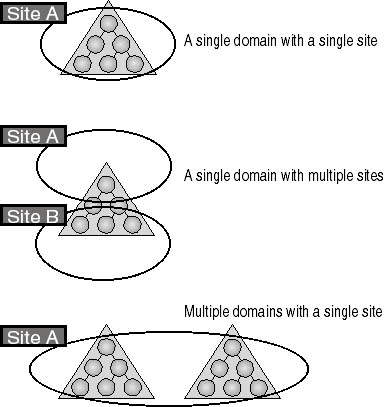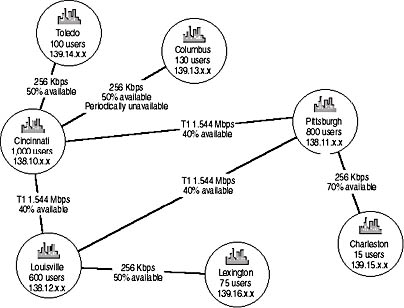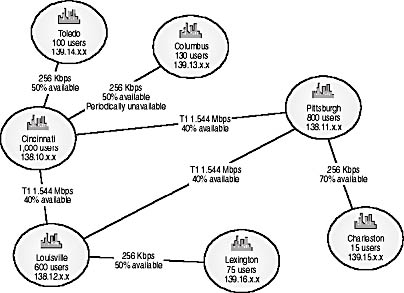Lesson 1: Defining Sites
The first step in creating a site topology plan is to define sites. To define sites, you must assess the organization's need for sites and then determine the sites for each forest in the organization. This lesson discusses how to define sites.
After this lesson, you will be able to
- Explain the purpose of sites
- Identify the factors in an organization's environment that impact its need for sites
- Analyze an organization's environment to define its sites
Estimated lesson time: 15 minutes
Understanding Sites
Recall that a site is a set of Internet Protocol (IP) subnets connected by a highly reliable and fast link (usually a LAN). Typically, networks with a bandwidth of at least 512 kilobits per second (Kbps) are considered fast networks. An average available bandwidth of 128 Kbps and higher is sufficient for designating a site. Average available bandwidth is the amount of bandwidth that is actually available for use during peak traffic after normal network traffic is handled.
In Active Directory, site structure mirrors the location of user communities. Site structure concerns the physical environment and is maintained separately from the logical environment, the domain structure. Because sites are independent of the domain structure, a single domain can include a single site or multiple sites, and a single site can include multiple domains, as shown in Figure 6.1.
The main purpose of a site is to physically group computers to optimize network traffic. Sites act to confine authentication and replication traffic to only the devices within a site. Because network traffic is prevented from unnecessarily crossing slow WAN links, traffic is limited. Sites have two main roles:
- To determine the nearest domain controller during workstation logon
- To optimize the replication of data between sites
Because site names are used in the records registered in DNS by the domain locator, they must be valid DNS names. Recall that valid DNS names consist of the standard characters A-Z, a-z, 0-9, and hyphen (-).

Figure 6.1 The relationship of site and domain structures
Design Step: Defining Sites
To define sites, you must complete the following tasks:
- Assess the organization's need for sites.
- Determine the sites for the organization.
Assessing the Need for Sites
To define sites, you must first consult the Network Architecture Worksheet compiled earlier by your design team. Use the Network Architecture Worksheet to determine
- The locations in which the organization has offices
- The speed of the LANs in each location and the percentage of average available bandwidth on each link during normal business hours
- The TCP/IP subnets in each location

NOTE
A blank copy of the worksheet is located on the Supplemental Course Materials CD-ROM (\chapt02\worksheets). A completed example of the worksheet is located in Chapter 2, "Introduction to Designing a Directory Services Infrastructure."
In addition to assessing the information in this worksheet, it is imperative that you assess any changes to the network architecture currently planned to address growth, flexibility, and the ideal design specifications of the organization.
Defining Sites for the Organization
Define a site for
- Each LAN or set of LANs that are connected by a high-speed backbone
- Each location that does not have direct connectivity to the rest of the network and is only reachable using SMTP mail
If an entire network consists of fast, reliable links, the network can be considered a single site. Similarly, if bandwidth between networks is plentiful and it is acceptable for a client on one network to communicate with a server on another network, the networks may together be considered a single site.
Subnets that are not defined in the directory are not considered part of a site. The subnets may be undefined because they have not yet been added to the network. Any clients on undefined subnets must then communicate randomly with all domain controllers in a domain, which may result in authentication delays. To eliminate these delays, you can associate the clients with a site by creating default subnets and then associating the subnets with a site. The default subnets are shown in Table 6.1.
Table 6.1 Default Subnets
| Subnet ID | Mask | Description |
|---|---|---|
| 128.0.0.0 | 192.0.0.0 | Captures all clients on Class B networks that are not yet defined in the directory. |
| 192.0.0.0 | 224.0.0.0 | Captures all clients on Class C networks that are not yet defined in the directory. |
No default subnet is provided for clients on Class A networks that are not yet defined in the directory.
To define sites
- Determine the site(s) needed to encompass each
- LAN or set of LANs that are connected by a high-speed backbone
- Location that does not have direct connectivity to the rest of the network and is only reachable using SMTP mail
- Create a site diagram:
- Use an oval to represent each site.
- Name each site using a valid DNS name.
- List the set of IP subnets that constitute each site.
Design Step Example: Defining Sites
Figure 6.2 shows the network architecture diagram for Margo Tea Company, a producer of herbal teas with seven locations. The company headquarters is located in Cincinnati, with regional offices in Pittsburgh and Louisville. The Toledo, Lexington, and Charleston locations are sales offices, and the company's distribution center is located in Columbus. The company operates within a single domain. Each location has a high-speed backbone that connects a set of 10—100 Kbps LANs.

Figure 6.2 Network architecture diagram for Margo Tea Company
Figure 6.3 shows the site diagram for Margo Tea Company. A site was defined for each location because each location has a high-speed backbone that connects a set of 10-100 Kbps LANs.

Figure 6.3 Site diagram for Margo Tea Company
Lesson Summary
In this lesson you learned how to define sites for an organization by assessing an organization's site needs and determining the location of its sites. You also learned the guidelines for defining a site: define a site for each LAN or set of LANs that are connected by a high-speed backbone and define a site for each location that does not have direct connectivity to the rest of the network and is reachable only by SMTP mail. Finally, you learned to create a site diagram that includes the name of each site and a listing of the set of IP subnets that constitute each site.
EAN: 2147483647
Pages: 76